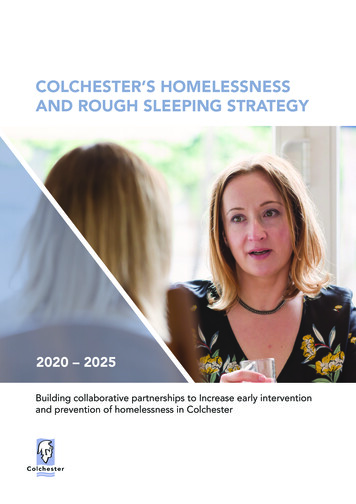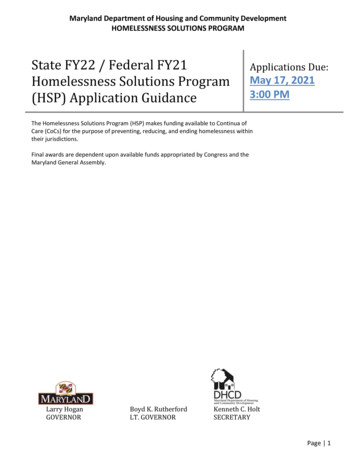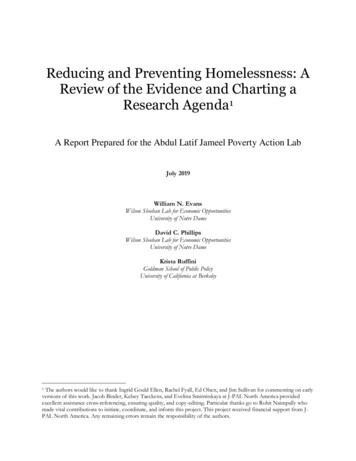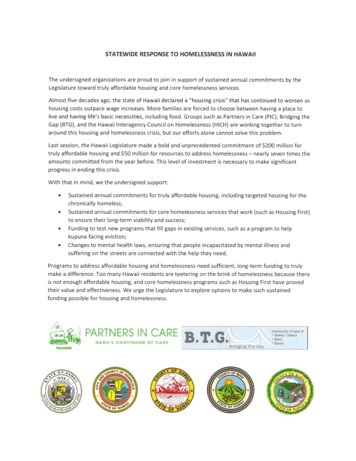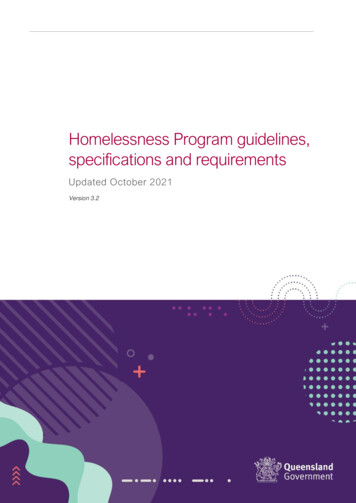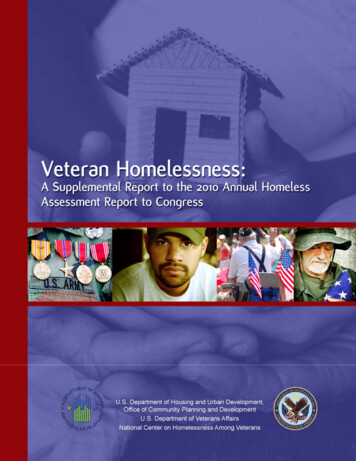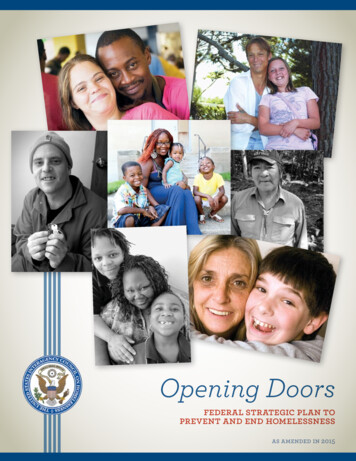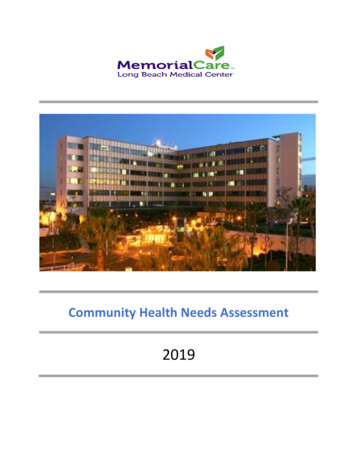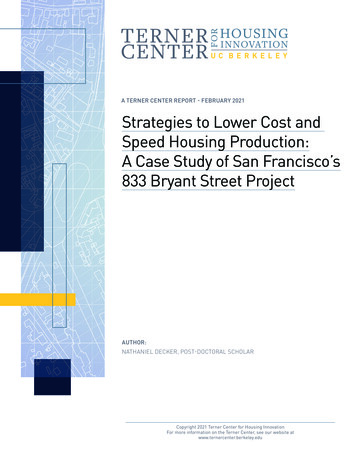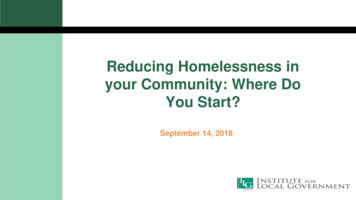
Transcription
Reducing Homelessness inyour Community: Where DoYou Start?September 14, 2018
SpeakersMelissa Kuehne – Communications Manager, Institute forLocal Government (Presiding)Paul Navazio, City Manager, City of WoodlandEmily Halcon, Homeless Services Coordinator, City ofSacramentoHelene Schneider, Regional Coordinator, US InteragencyCouncil on Homelessnesswww.ca-ilg.orgwww.ca-ilg.org
Homelessness in California California accounted for nearly half of all unsheltered people in thecountry in 2017 (49%). Half of all people experiencing homelessness did so in one of fivestates: California (25% or 134,278 people); New York (16% or89,503 people); Florida (6% or 32,190 people); Texas (4% or23,548 people); or Washington (4% or 21,112 people).www.ca-ilg.orgwww.ca-ilg.orgDepartment of Housing and Urban Development 2017 Annual Homeless Assessment Report to Congress
Joint League/CSACHomelessness Task Force Mission Statement: “to provide needededucation, identify resources and developpolicy that cities and counties need toprevent, assist and reduce the number ofindividuals and families experiencinghomelessness in our communities.” Co-Chairs: Grass Valley Councilwoman JanArbuckle and Yolo County Supervisor OscarVillegaswww.ca-ilg.orgwww.ca-ilg.org
Joint League/CSACHomelessness Task ForceExamine homelessness in CADiscuss collaborative local solutionsProvide education and resourceswww.ca-ilg.orgwww.ca-ilg.org
Task Force ReportI. IntroductionII. Assessing the Cost ofHomelessnessIII. Funding OptionsIV. Existing and EmergingApproachesV. Creating a HomelessnessPlanVI. Partnering for GreaterImpactVII.Building Support for theSpectrum of Housing in theCommunity—PublicOutreach and orgwww.ca-ilg.org/homelessness
IntroductionState of Homelessness From 2016 to 2017, homelessness inCalifornia increased 13.7% 134,278 Californians counted ashomeless Experts agree that the number ofpeople without housing is 3 to 4 timeshigher than recordedCauses of Homelessness Lack of affordable housing Poverty Lack of affordable health care Domestic violence Mental illness Addictionwww.ca-ilg.orgwww.ca-ilg.org
Assessing the Cost of HomelessnessData Collection and Sharing Allows cities and counties tounderstand the demographics andneeds of their homeless populationsas well as track the associated costs.Silicon Valley Triage Toolwww.ca-ilg.orgwww.ca-ilg.orgSan Diego’s Project 25Preventative Services and CostSavings Addressing homelessness early onand implementing preventativeservices and strategies can savejurisdictions resources and revenuein the long run.
Funding OptionsExamples: San Jose - StreamlinedTemporary and IncidentalShelter Program Marin County LandlordPartnership Program LA County Landlord IncentiveProgramswww.ca-ilg.orgwww.ca-ilg.org
Existing and Emerging ApproachesHousingVeteransHealth and Social ServicesFamiliesLaw EnforcementSt John’s Program For Real Changewww.ca-ilg.orgwww.ca-ilg.orgLocal Examples: Yolo County, Bridge to Housing Yuba County, 14 Forward City of Fresno, Poverello House City of San Diego, Housing Our Heroes Alameda County, Care Connect Marin County, Homeless Outreach Team San Mateo County, LifeMoves St. John’s Program for Real Change City of Bakersfield Homeless Center Downtown Streets Team City of Citrus Heights Navigator Program City of Anaheim Homeless Outreach Team
Creating a Homelessness Planwww.ca-ilg.orgwww.ca-ilg.org
Partnering for Greater ImpactMore efficient use of resourcesIncreased effectiveness in the communityExamples: LA Home for Good Sacramento StepsForward San Leandro HomelessCompact LA Interfaith Summit onHomelessnessLA Home for Good – Walkwww.ca-ilg.orgwww.ca-ilg.org
Building Support for the Spectrumof Housing in the Community Engaging the Public in Planning for Housing Building Healthy and Vibrant Communities: Achieving Resultsthrough Community Engagement TIERS Public Engagement Framework Beyond the Usuals: Ideas to Encourage Broader PublicEngagement in Community Decision Making Partnering with Community-Based Organizations for More BroadBased Public Engagement Dealing with Deeply Held Concerns and other Challenges toPublic Engagement Processes Effective Public Engagement through Strategic Communication Planning Public Engagement: Key Questions for Local OfficialsTo access these resources and more, visit the ILG’s website at .org
Share Your Storywww.ca-ilg.orgwww.ca-ilg.org
Paul NavazioCity ManagerLeague of California CitiesAnnual Conference - September 14, 2018
Case Study – City of Woodland Sacramento Valley Division Yolo County Seat Population 55,500
2017 Point-in-Time Homeless Count
Say WHAT.? Homeless Count does not pass the “eye-ball” test Who are these folks, where are they coming from, how did they get here? Who’s responsibility is this? County Seat” Complex (sic) Complaints Mounting Drain on City Resources
All-Staff Brainstorming Series of Brown Bag Lunch meetings What is Staff dealing with What can City Management do to assist? What resources would be helpful? Policies / Ordinances / Enforcement tools How best to coordinate our INTERNAL city efforts
Issues / ResponseNeedlesKnives/WeaponsLibraryElectrical OutletsHuman WasteFightsDumpstersPanhandling GarbageCoordinated ServicesMental HealthProstitutionBroken Water LinesCity Hall PatioVandalismArsonEncampmentsAbsentee SlumlordsScrap Metal TheftsHuman WasteShopping CartsNeedlesRehab / TreatmentBlighted PropertiesSheltersDrugs
Homeless Action ction-Plan HOUSING Initiatives that contribute to ENDING HOMELESSNESS “Housing First” Model SHELTER /SERVICES Efforts to ENHANCE CAPACITY of services/shelters Addressing needs of homeless UNTIL housing solutions bear fruit MANAGING IMPACTS ADDRESSING IMPACTS of Homelessness in our Community
Managing Impacts of Homelessness
Managing Impacts of Homelessness
Homeless Action PlanServices / Shelters
Homeless Action PlanHousing
Homeless Action PlanHighlightsInitiated Police Department-led Homeless Outreach Street Team (HOST) Documented 275 individuals as of June 2018 Over 225 contacts with homeless Over 70 camps visited Over 130 offers of service Over 50 business contacts Over 1,200 shopping carts picked upCamp Clean-Ups - Agreements in place with CalTrans and CHP for coordinatedclean-up and monitoring of freeway right-of-way and sound wallscoordination with Northern Pacific and Sierra Northern railroads
Homeless Action PlanHighlights Initiated Emergency Winter Shelter Partnership with faith-based community Implemented Regular Multi-disciplinary Team Meetings City Manager’s Office, Woodland Police, County HHS, District Attorney,Probation, Community-based Service Organizations, Dignity Health Hired Social Services Manager Case manages referral to social services Coordination with County, cities and service providers Expansion of Fourth & Hope Shelter Services Starting Day Services 9/12/18 City providing portable toilets / showers
Homeless Action PlanMicro-Neighborhood Project
Ongoing Challenges Clean-ups and enforcement do not SOLVE problems;merely displace people, shifts problem to new location Public perception that City is not aggressively enforcinglaws and city ordinances Many programs / funding sources are restricted to specificpopulations Coordination across jurisdictions remains a challenge Competition for funding Lack of comprehensive County-wide strategy
Need for Public Information and Education
A City Oriented Response to HomelessnessLeague of California CitiesSeptember 14, 2018
Homeless Point-in-Time CountSacramento County, 1320152017
Homelessness in SacramentoJanuary – June, 201821,913 calls to policeregarding homelessrelated activities2,266 service referralsmade by policeIMPACT team812 encampmentsreported throughCity 3112,844 cubic yards ofdebris removed fromabandonedencampments
Homeless Death ReportSacramento County, 45462009201060717871432011Homeless Deaths201220132014201520162017
A City ResponseSafety The City is committed to the safety of all residents. Thisincludes meeting the immediate safety needs of thoseexperiencing homelessnessStability The City is committed to ensuring individuals haveaccess to the services necessary to transition from thestreets or temporary shelters into permanent housingSuccess The City is committed to supporting to helping transitionindividuals into permanent housing and helping themmaintain long-term housing
A City ResponseSafety:AssertiveOutreach &EngagementStability:EmergencyShelter &TriageSuccess:PermanentHousing &SupportiveServicesPrevention &Diversion
Safety: Crisis Response – SPD Impact Team› 1 lieutenant, 1 sergeant, 7 officers› Respond to encampments City-wide› Service oriented approach› Mental health intervention› Community outreach partnershipsAnnually: 4,656 referrals for service/housing6,451 cubic yards of debris removed
Stability:Railroad TriageShelter Up to 200 individuals nightly Focused outreach in community Access by outreach - no walk ups! 24/7 staffing and security On-site services, focusing on housing,health, & income acquisition Opened December 2017 135 positive exits (as of 8/15)
Success:› Four-year pilot program for high-riskMedi-Cal beneficiaries who arefrequent users of multiple caresystems and have poor xibilityShared DataWholePersonCareCoordinationof teredCare› Provides flexible federal funding toimprove health and housing outcomesand more efficiently and effectivelyuse health care resources.› Pilots identify target populations,assess health and housing needs,coordinate care in real-time, andevaluate outcomes.› Promotes deeper collaboration andcoordination between serviceproviders by requiring pilots to formpartnerships and share data
Success:› Vulnerable, unshelteredpopulations› Individuals with complexhealth care needs› Frequent users ofemergency services &crisis health system› High-risk individuals exitinginstitutionsOutreach6,800 “touches”CareCoordination3,250 individualsHousingSupport1,650 individualsRespite Beds144 individuals
Upcoming ativeHousingPrevention& Diversion
USICH & League of CA CitiesPartnerships & Political WillHelene Schneider, Regional CoordinatorSeptember 14, 2018
Statutory Authority and MissionU.S. Interagency Council on Homelessness (USICH) ischarged with: Coordinating the federal response to homelessness Creating a national partnership at every level of government andwith the private sector to reduce and end homelessness in thenation Maximizing the effectiveness of the federal government incontributing to the end of homelessness44
Coordinating the Federal Response The Council Council Policy Group Interagency Working Groups Performance measurementand accountability45
USICH Roles and Activities DC-Based Policy Team – Coordinating strategies acrossfederal agencies Field-based National Initiatives Team – Driving progressin communities Communications Activities – Providing tools andresources to strengthen practices46
USICH Regions: National Initiatives Team47
Connector of Dots Slayer of Bureaucratic Demons48
My introduction to USICH:El Carrillo, Santa Barbara Grand Opening, 200649
Political Will is Essential50
City of Santa BarbaraRDA fundsGrant to HASBCouncil on Alcohol &Drug Abuse “ProjectRecovery”Administers ProgramHASB Purchases& Manages PropertySanta Barbara CountyBehavioral Health Dept.Contracts with CADA51
Project Recovery Success:July 2012 – March 2018Number of Clients admitted: 115435% Women; 65% MenClients reporting as Homeless: 807 70%41% discharged to improved housing73% clients successfully discharged after 14days in program80% discharged clients continued on with otheroutpatient services52
USICH Areas of Increased Focus Increasing affordable housing opportunities Strengthening prevention and diversion practices Creating solutions for unsheltered homelessness Tailoring strategies for rural communities Helping people who exit homelessness to find career successand economic mobility Learning from the expertise of people with lived experiences ofhomelessness53
Home.Because we know that theonly true end tohomelessness is a safe andstable place to call home.Together.Because the solutions aregoing to take all of usworking together, doing ourparts, strengthening ourcommunities.55
Our Shared National Goals Ending homelessness amongVeterans Ending chronic homelessnessamong people with disabilities Ending homelessness amongfamilies with children Ending homelessness amongunaccompanied youth Ending homelessness among allother individuals56
Structure for PlanOperational definition: Comprehensiveresponse that ensures homelessness isprevented whenever possible, or if itcan’t be prevented, it is a rare, brief,and one-time experience.Criteria and benchmarks: Essentialelements of comprehensive systemsand the outcomes those systems mustbe able to achieve.57
1) Ensure Homelessness is a Rare ExperienceObjective 1.1: Collaboratively Build Lasting Systems that EndHomelessnessObjective 1.2: Increase Capacity and Strengthen Practices toPrevent Housing Crises and Homelessness58
2) Ensure Homelessness is a Brief ExperienceObjective 2.1: Identify and Engage All People ExperiencingHomelessness as Quickly as PossibleObjective 2.2: Provide Immediate Access to Low-BarrierEmergency Shelter or other Temporary Accommodations to AllWho Need ItObjective 2.3: Implement Coordinated Entry to StandardizeAssessment and Prioritization Processes and StreamlineConnections to Housing and ServicesObjective 2.4: Assist People to Move Swiftly into PermanentHousing with Appropriate and Person-Centered Services59
3) Ensure Homelessness is a One-TimeExperienceObjective 3.1: Prevent Returns toHomelessness through Connections toAdequate Services and Opportunities60
4) Sustain an End to HomelessnessObjective 4.1: Sustain Practices andSystems at a Scale Necessary to Respondto Future Needs61
Challenges withEncampments andUnsheltered Homelessness62
Addressing Encampments &Unsheltered Homelessness Get good data, establish a benchmark Create & enhance partnerships & collaboratives Invest in Outreach Services, use a coordinated entry system Allow for low barrier emergency shelters Focus on Housing-First Models Ensure sustainability Share best practices63
OPPORTUNITY! New State Resources Creation of CA Coordinating Council withfunded staffing 600M in FY19 State Budget for homelessnessrelated services Prop 2 FundsHow is your City coordinating with yourContinuum of Care (CoC)?64
Ingredients towards Success Political Will Effective Use of Adequate Resources Collaborative Approach “Never Give Up” Attitude65
Why it Matters66
www.usich.gov
Questions?www.ca-ilg.orgwww.ca-ilg.org
Contact Information/Stay in TouchEmily Halconehalcon@cityofsacramento.orgHelene SchneiderHelene.Schneider@usich.gov@Helene USICHPaul Navazio530-661-5800Melissa Kuehnemkuehne@ca-ilg.org(916) 658-8202www.ca-ilg.orgwww.ca-ilg.org
frequent users of multiple care systems and have poor health outcomes. ›Provides flexible federal funding to improve health and housing outcomes and more efficiently and effectively use health care resources. ›Pilots identify target populations, assess health and housing needs, coordinate care in real-time, and evaluate outcomes.
